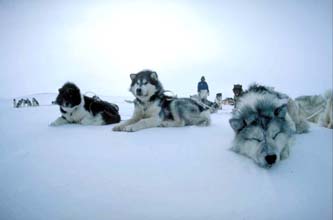Table of Contents
*
Fan Mail
*
F.I.D.O.: Ludovic Pirani
*
Geronimo's Travels
*
The Breeding and Maintenance of Sledge Dogs: Part I
*
How We Met Tom
*
Dog Yard Tips
*
Setting a New Standard
*
In the News
*
Behavior Notebook: Qiniliq and Sunny
*
IMHO: Unnecessary Roughness
Navigating This
Site
Index of articles by subject
Index
of back issues by volume number
Search The
Fan Hitch
Articles
to download and print
Ordering
Ken MacRury's Thesis
Our
comprehensive list of resources
Talk
to The
Fan Hitch
The Fan
Hitch home page
ISDI
home page
Editor: Sue Hamilton
Webmaster: Mark Hamilton
Contents of The Fan Hitch Website and its publications are protected by international copyright laws. No photo, drawing or text may be reproduced in any form without written consent. Webmasters please note: written consent is necessary before linking this site to yours! Please forward requests to Sue Hamilton, 55 Town Line Rd., Harwinton, Connecticut 06791, USA or mail@thefanhitch.org

Nunavut Tourism photo
Setting a New Standard:
Putting Four Thousand Years of
Nature-Made Dog into
Words
by Sue Hamilton
Changes in a breed standard should raise the bar to reaffirm a breed's original purpose, not lower it. For example, in the 1994 change to the Alaskan Malamute standard, a new color not previously included (and in an obtuse way was disallowed because "lips black" was specifically described) was added - red. Perhaps this may not seem a big deal to those familiar with ISDs, as red is a common color in our breed and one might go so far as to say that the Alaskan Malamute is nothing more than a watered down (drowned?) descendant of an ISD. On the other hand, this was a very big deal to malamute purists who felt that the campaign by some members of the Alaskan Malamute Club of America to have reds officially included was nothing more than an attempt to legitimize a bastard - to rewrite the breed's history leading to AKC registration. Dog show judges who chose to ignore the words "lips black" as written in the previous standard (a part of the original), were already awarding points to reds and even making champions of a few instead of dismissing them because red dogs can't have black lips (or noses). When the "red brigade" finally managed to ram in enough votes to pass the change, they somehow felt their red dogs were validated. And it all had not one iota to do with the improvement of the Alaskan Malamute as a working sled dog. It was all about the show dog. Plain and simple… and pathetic.
Long time readers of The Fan Hitch (some of whom may breed, own and show red malamutes) have probably heard a variation of this theme from me before. But it is time that this analogy to what is happening in the world of Inuit Sled Dogs is dragged up once again. Why?
Enthusiasts have been howling for years over the decline in numbers of pure Inuit Sled Dogs in arctic Canada, and are seeking various ways to promote its resurgence there. We have heard it said more than once that the younger generation of Inuit don't know what a pure ISD looks like. After all, contamination of the breed began way more than a generation ago, one reason why pure dogs are few and far between. So how can there be a resurgence of pure ISDs in the Arctic if the folks who need to know what a pure ISD actually looks like don't know what a pure ISD actually looks like? Despite the Nunavut Quest's regulation that competing dogs be "the dogs of our ancestors", many dogs running the Quest are obviously anything but pure. And it is our understanding that this situation is only getting worse. In Nunavik, the situation sounds more hopeful. But we have been informed that the breed description in the Ivakkak Sled Dog Race rules comes from a mid-twentieth century European explorer. His portrayal was somewhat modified by the race participants, based on what they believed the pure dogs were like. With all due respect to them, I am wondering if this might be a conflict of interest. If it isn't so (I offer my apologies), then how could the participants not old enough to have experienced pure dogs know what they were really like? And it was said Nunavik elders were not consulted for their agreement of the breed as it was described in words.
The current official Canadian Kennel Club (CKC) breed description for the Canadian Eskimo Dog (CED) is worthless in defining an Inuit Sled Dog, the pure dog of the CED's ancestors. That breed standard is now a contrivance for those seeking a way to quantify a specimen for purposes of being judged at a dog show - so many points for the head, the tail and body parts in between. To ask Inuit to identify pure ISDs and to reproduce and use them for their original purpose based on the CKC standard is a joke, and a bad one at that. The Inuit Sled Dog was created prior to written language without "benefit" of measuring sticks, protractors, freight scales… and best of breed trophies!
And so if we wish to continue to see the Inuit Sled Dog alive and well in the land of its origin, and because the number of elders who have the experience to help define the pure ISD are dwindling, a functional standard needs to be created with their oversight, and soon. Elders' descriptions of their dogs need to be put to paper and along with that, their approval of phenotype based on archival early twentieth century photographs showing good typical working pure stock prior to their contamination by dogs brought north from elsewhere.
Who is willing to take up this cause?